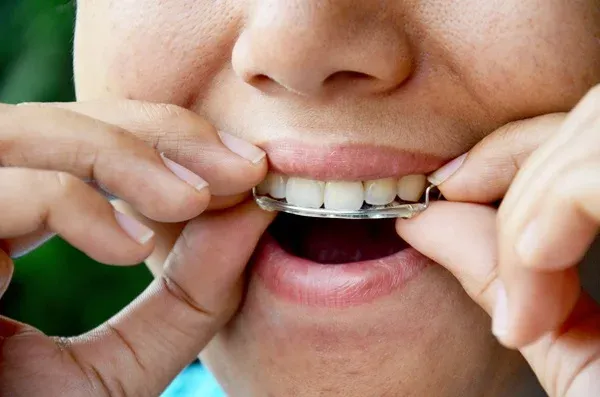Maintaining Results After Invisalign: Retention and Follow-Up Care
Once you have your Invisalign treatment and get your desired smile, there is more to it than just that. The maintenance is done by wearing retainers, which are very important in ensuring that your teeth remain in their new perfect positions. If you do not maintain the retainers, your teeth will slowly go back to their previous positions, and all the treatment will be in vain. In this part of the article, you will learn why retention is crucial, the different types of retainers, and how they help in sustaining your beautiful smile.
Understanding the Role of Retainers Post-Invisalign
Retainers are crucial assets for maintaining the results that Invisalign has offered you. After the teeth have been aligned, they are not protected from moving back to the previous position because the gums and the bones are known to shift naturally. Retainers are used to maintain the new position of your teeth since the surrounding tissues require some time to create a firm hold on the teeth. Compliance with the use of retainers, as advised by your orthodontist, is the best way to maintain a beautiful smile for many years to come.
Choosing the Right Retainer for You
There are several types of retainers, and each one has its advantages and disadvantages. The most common options include:
- Hawley Retainers: These are made of acrylic and metal and can be adjusted to provide a good means of maintaining the alignment. They are easy to clean because they are removable, but the visible wire may be a disadvantage to some.
- Clear Plastic Retainers (Essix): These retainers are somewhat similar to Invisalign aligners in that they are nearly invisible. They can also be removed, but they are not as durable as the fixed ones and may require replacement more often.
- Fixed Retainers: Fixed to the back of your teeth, fixed retainers are a more permanent solution that cannot be removed and require no cleaning. However, they need proper care to avoid the formation of plaque on the teeth.
The type of retainer to be used depends on the individual’s lifestyle, personal preference concerning the type of retainer, and the doctor’s advice.
Daily Retainer Care: Dos and Don’ts
It is crucial to maintain your retainer as clean as possible to guarantee that it continues to function as planned. Here’s a guide to help you maintain your retainer and prolong its lifespan:
Dos:
- Clean Your Retainer Daily: Rinse your retainer in warm water and clean it with a soft toothbrush and a non-toxic toothpaste or soap to get rid of plaque and bacteria.
- Soak in a Cleaning Solution: Soak your retainer in a retainer cleaning solution or in water and baking soda to keep it clean and smell-free.
- Store Properly: When not wearing your retainer, it should be placed in its case to minimize any harm that may be caused to it or accumulation of dirt on it.
- Handle with Care: Be careful when removing your retainer; do not bend or twist it; if it is a clear plastic retainer, then be extra careful.
Don’ts:
- Avoid Hot Water: Do not wash your retainer under hot water because this can distort the shape of the retainer and thus not serve its purpose.
- Skip Harsh Chemicals: Do not use bleach, alcohol-based mouth, or any other chemicals for cleaning because they will corrode the material and make your retainer unsafe for use.
- Don’t Eat with Your Retainer: When wearing a retainer, it is advised that you take it out when eating to avoid damaging it and to also avoid the food particles that may stick to it, thus causing bacterial formation.

- Don’t Leave It Out: Do not place your retainer anywhere exposed or wrapped in a napkin; it is very easy to misplace or even damage.
By adhering to these dos and don’ts, your retainer will remain in good condition, thus continuing to serve its purpose of maintaining your beautiful smile.
Signs Your Teeth May Be Shifting
In some cases, even after the treatment and wearing the retainer as advised, minor changes in the position of the teeth are still noticeable. It is important to know the signs of teeth shifting early enough so that you can treat it before it gets worse. Here are some indicators that your teeth might be moving out of alignment:
- Tight or Loose Retainer Fit: If your retainer feels tighter or looser than it was when you first got it, then your teeth may be moving.
- Changes in Bite: If you feel that your bite has changed or that your teeth do not fit together anymore the way they used to when your mouth is closed, this may mean movement.
- Gaps or Crowding: Any gaps that you had between your teeth closing up or teeth that start to overlap are signs of shifting.
- Difficulty Flossing: If it becomes difficult or easy to floss between some teeth, it may be a result of a shift in the position of the teeth.
- Pain or Discomfort: Any discomfort or pain in the teeth or jaw that cannot be explained could be due to teeth movement, especially in the presence of the above symptoms.
- Noticeable Changes in Appearance: If the smile line is not symmetrical or if some of the teeth seem to be misaligned, this is a clear indication that shifting has occurred.
These are some of the signs that you should visit the orthodontist as soon as possible: It is important to note that after the Invisalign treatment is complete, further shifting can occur if intervention is not made to prevent it.
Addressing Common Retainer Issues
- Retainer Doesn’t Fit Properly: There are cases when a retainer feels too tight, too loose, or uncomfortable, and this means that it does not fit properly. This could be a result of teeth moving back to their initial positions, a problem with the Retainer, or wearing of the Retainer. You should contact your orthodontist for an adjustment or replacement to have your teeth in the right position.
- Broken or Damaged Retainer: Retainers can also chip, bend, or even snap, especially when not well handled. If your Retainer is broken, do not wear it and visit your orthodontist for a replacement to avoid shifting the teeth.
- Difficulty Speaking: First, a retainer may cause speaking difficulties. Try to speak with your Retainer as soon as possible, and the adaptation period should be over in less than a week. If the problem continues, it is advisable to contact your orthodontist because the Retainer may require some adjustments.
- Excessive Saliva Production: The first thing that you are likely to notice is that you are producing more saliva than usual, especially when you are new to the use of retainers. Your mouth will normally take about a week or so to adapt to the new dentures. This effect can be minimized by drinking lots of water and wearing the Retainer as instructed.
- Unpleasant Odors or Taste: If your Retainer has a foul smell or taste, it is advisable to take it that it has been colonized by bacteria. To maintain the cleanliness of the Retainer, you should clean it every day using a soft brush and some mild soap and soak it in a retainer cleaner.
- Retainer Causing Soreness: Mild soreness is expected when one is wearing the Retainer for the first time or after a visit to the orthodontist for an adjustment. However, pain that lasts for long could be an indication that the shoes do not fit well. Visit your orthodontist for an examination and make sure the Retainer is not placed in the wrong position and does not apply pressure on the teeth.
If these problems are not resolved, it can lead to the failure of the Retainer, which means you will not be able to keep your Invisalign results and maintain the proper alignment of your teeth.
Maintaining Your Smile: Tips for Long-Term Success
- Follow Retainer Instructions: Follow all instructions given by the orthodontist regarding the use of retainers. First, this may entail wearing it all the time and then gradually moving to wearing it at night, but the important thing is that the wearer should stick to it.
- Regular Dental Check-Ups: Make regular appointments with your dentist and orthodontist to check on your teeth and gums and any signs of problems. They also help check on the functionality of your Retainer and whether it is in place or not.
- Maintain Excellent Oral Hygiene: Clean your teeth using a toothbrush and floss at least twice a day to avoid the formation of plaque and gingivitis. Fluoride toothpaste helps you maintain healthy teeth and gums, so it is recommended to use it.
- Clean Your Retainer Properly: Please refer to the cleaning instructions of your Retainer to prevent bacterial and foul smell formation. Cleaning is important to ensure that the Retainer lasts longer and maintains good oral hygiene.

- Be Mindful of Diet: Do not bite on any hard objects such as pen, ice, or any other hard object since they are bad for your Retainer. Also, avoid foods that are sticky or contain a lot of sugar, as they can harm the teeth.
- Monitor Changes in Your Smile: Note any shift in the position of your teeth or any changes in the fit of your Retainer. If you feel any movement or pain, do not hesitate to visit your orthodontist.
- Adjust as Needed: You should expect to change your Retainer wearing schedule from time to time, depending on what the orthodontist has to say. A check-up may be required after some time to ensure that the teeth are well aligned.
- Commit to Long-Term Care: Keep in mind that the process of preserving your beautiful smile is a lifelong one. Maintaining a follow-up appointment will assist in making sure that your beautiful smile remains straight and healthy in the future.
Contact your Danville dentist, Dr. Hoss Abar, DDS, MSD, at Danville Orthodontics to learn more about maintaining results after Invisalign.
Resource:
Beyond Braces: How Surgical Orthodontics Can Transform Your Smile?
*Neither this nor any other content in this media is meant to prescribe, recommend, or prevent any treatment or procedure. We highly suggest that you get the advice of a qualified dentist or other medical practitioners regarding your specific dental condition.
